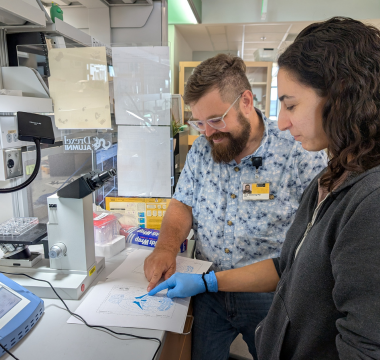Meet a Researcher Aiming to Improve Early Detection and Diagnosis of PD

Parkinson’s disease (PD) can be difficult to diagnose by clinicians, especially in early stages of the disease. This means that some people with PD may get diagnoses only late in the disease when the symptoms are more obvious. Others may never get a formal diagnosis at all.
Jacob Simmering, PhD, recipient of a Parkinson’s Foundation Stanley Fahn Junior Faculty Award, is digging through healthcare data to find clues that could lead to earlier and more accurate diagnoses of PD. Using statistical analysis, he hopes to identify diagnostic patterns that commonly precede PD and that could be used as future medical signposts, guiding doctors toward earlier detection of the disease.
“This award is crucial to my career development as a researcher in Parkinson’s disease,” said Dr. Simmering. “Parkinson’s disease is a common neurodegenerative disease without any disease-modifying, neuroprotective therapies. One issue with degenerative diseases is that the damage is irreversible. By the time clinical symptoms become apparent, the disease is often very advanced in terms of neuronal death. Earlier intervention may allow for treatments that preserve neurons — slowing, if not preventing, progression.”

From his lab at the University of Iowa, a Parkinson’s Foundation Center of Excellence, Dr. Simmering is utilizing health insurance databases to collect healthcare data on nearly 250,000 deidentified people recently diagnosed with PD. From this information, he hopes to identify a “diagnostic window” for PD—a stretch of time with repeated doctor’s visits for PD-like symptoms signaling the presence of the disease.
Dr. Simmering will then use this diagnostic window as a frame, looking at people with recent diagnoses and figuring out what prevented physicians from diagnosing PD sooner. His hypothesis is that the three biggest factors that play into delayed diagnoses are:
-
Unique symptom patterns of PD
-
Living in more rural areas
-
Not being seen by a neurologist
Sorting through this data will provide evidence for other repeated symptoms that could clue doctors into a PD diagnosis earlier. While tremor and involuntary movements are most commonly used to lead to a PD diagnosis, other symptoms like urinary problems and anxiety could be just as valuable. Altogether, Dr. Simmering will use this detailed analysis to generate a forward-looking “risk score” to identify people who are most at risk of developing PD.
“These results will allow us to screen for people who have symptoms and characteristics similar to people who will go on to be diagnosed with Parkinson's disease, potentially allowing for earlier detection of disease,” said Dr. Simmering.
Earlier detection means providing symptom relief sooner to those with the disease, improving their quality of life with early treatment.
Meet more Parkinson’s researchers! Explore our My PD Stories featuring PD researchers.
Related Materials
Related Blog Posts

Neuro Talk: Newly Diagnosed

20 Parkinson’s-Friendly Gifts
